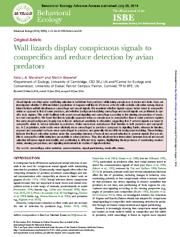A copy of this work was available on the public web and has been preserved in the Wayback Machine. The capture dates from 2017; you can also visit the original URL.
The file type is application/pdf.
Wall lizards display conspicuous signals to conspecifics and reduce detection by avian predators
2014
Behavioral Ecology
Visual signals are often under conflicting selection to be hidden from predators while being conspicuous to mates and rivals. Here, we investigated whether 3 different island populations of Aegean wall lizards (Podarcis erhardii) with variable coloration among diverse island habitats exhibit simultaneous camouflage and sexual signals. We examined whether signals appear better tuned to conspecific vision as opposed to that of avian predators, and whether background-matching camouflage and sexual
doi:10.1093/beheco/aru126
pmid:25419083
pmcid:PMC4235580
fatcat:j6s5yivn5vcorgf2t5cornpwkm

